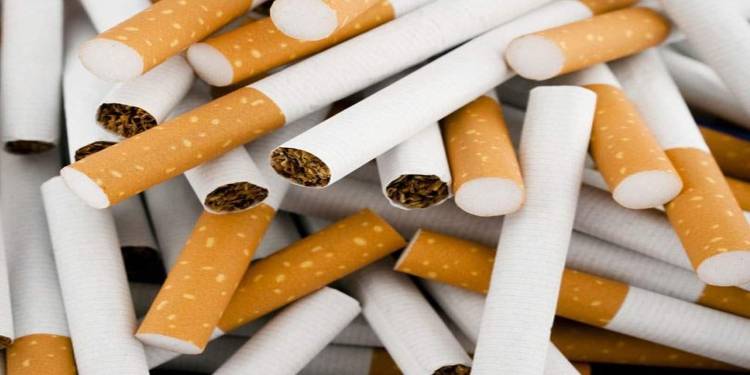
During an event organized by the Society for the Protection of the Rights of the Child (SPARC) in collaboration with the Social Policy and Development Centre (SPDC), health activists showed declared statistics of cigarettes produced by the tobacco industry in Pakistan to highlight that, in most of the cases, declared production in June is lower than average.
The declared production declined from 4,006 million sticks in February 2023 to 2,665 million sticks in March 2023. According to health activists, these are the industry’s tactics to influence policymakers. Because if this decline is due to a higher tax rate, then why did the production decline from 4,510 in June 2022 to only 1,021 in July 2022 when the tax wasn’t increased?
Muhammad Sabir, Principal Economist of SPDC said that, with the tax rate enhancements, cigarette prices have also increased. The per-pack price of the most popular economy brand increased from PKR 80 to PKR 211, while the price of a premium brand rose from PKR 179 to PKR 483. In percentage terms, the overall price increase was 164 percent and 170 percent, respectively. However, cigarette manufacturers have also kept increasing their net-of-tax prices (producers' prices). For instance, the producers' price of the Economy brand increased by 121 percent, much higher than the prevailing inflation rate. Altogether, the total tax on economy brands (FED and GST) rose by PKR 89 per pack (from PKR 45 to PKR 133). On the contrary, the consumer price increased by PKR 131. Due to over-shifting, the excise tax share in retail price remains at 51.6%, lower than the widely-accepted benchmark of 70%.
Malik Imran, Country head of Campaign for Tobacco-Free Kids (CTFK) stated, that the tobacco industry has always tried to derail the government’s efforts of reducing tobacco hazards by using the illicit trade excuse. Illicit trade is a reality but it is overstated by the tobacco industry. In reality, the tobacco industry practices underreporting where they hide their actual production figures to avoid taxes. Cigarette manufacturers also shift the tax burden to consumers to increase their own profitability. Imran quoted an example that, the declared production in July 2022 was decreased to only 1.02 billion from 4.5 billion sticks in June 2022. He said that even with the reduced production, the government is likely to generate additional revenue of over 10 billion rupees due to higher tax rates. Therefore, the policy of enhancing tax rates should be continued.
Khalil Ahmed Dogar, Program Manager SPARC said that the pandemic of tobacco is causing 465 deaths and making 1200 children addicted every day. Tobacco Control efforts require bold steps and the government’s decision to increase tobacco prices is a much-needed and praiseworthy step. This decision has already paid dividends for the economy and it will generate more revenue as well as decrease health burden. However, to achieve this double benefit, the government must remain steadfast by not falling for the tobacco industry’s misinformation campaign.
The declared production declined from 4,006 million sticks in February 2023 to 2,665 million sticks in March 2023. According to health activists, these are the industry’s tactics to influence policymakers. Because if this decline is due to a higher tax rate, then why did the production decline from 4,510 in June 2022 to only 1,021 in July 2022 when the tax wasn’t increased?
Muhammad Sabir, Principal Economist of SPDC said that, with the tax rate enhancements, cigarette prices have also increased. The per-pack price of the most popular economy brand increased from PKR 80 to PKR 211, while the price of a premium brand rose from PKR 179 to PKR 483. In percentage terms, the overall price increase was 164 percent and 170 percent, respectively. However, cigarette manufacturers have also kept increasing their net-of-tax prices (producers' prices). For instance, the producers' price of the Economy brand increased by 121 percent, much higher than the prevailing inflation rate. Altogether, the total tax on economy brands (FED and GST) rose by PKR 89 per pack (from PKR 45 to PKR 133). On the contrary, the consumer price increased by PKR 131. Due to over-shifting, the excise tax share in retail price remains at 51.6%, lower than the widely-accepted benchmark of 70%.
Malik Imran, Country head of Campaign for Tobacco-Free Kids (CTFK) stated, that the tobacco industry has always tried to derail the government’s efforts of reducing tobacco hazards by using the illicit trade excuse. Illicit trade is a reality but it is overstated by the tobacco industry. In reality, the tobacco industry practices underreporting where they hide their actual production figures to avoid taxes. Cigarette manufacturers also shift the tax burden to consumers to increase their own profitability. Imran quoted an example that, the declared production in July 2022 was decreased to only 1.02 billion from 4.5 billion sticks in June 2022. He said that even with the reduced production, the government is likely to generate additional revenue of over 10 billion rupees due to higher tax rates. Therefore, the policy of enhancing tax rates should be continued.
Khalil Ahmed Dogar, Program Manager SPARC said that the pandemic of tobacco is causing 465 deaths and making 1200 children addicted every day. Tobacco Control efforts require bold steps and the government’s decision to increase tobacco prices is a much-needed and praiseworthy step. This decision has already paid dividends for the economy and it will generate more revenue as well as decrease health burden. However, to achieve this double benefit, the government must remain steadfast by not falling for the tobacco industry’s misinformation campaign.

